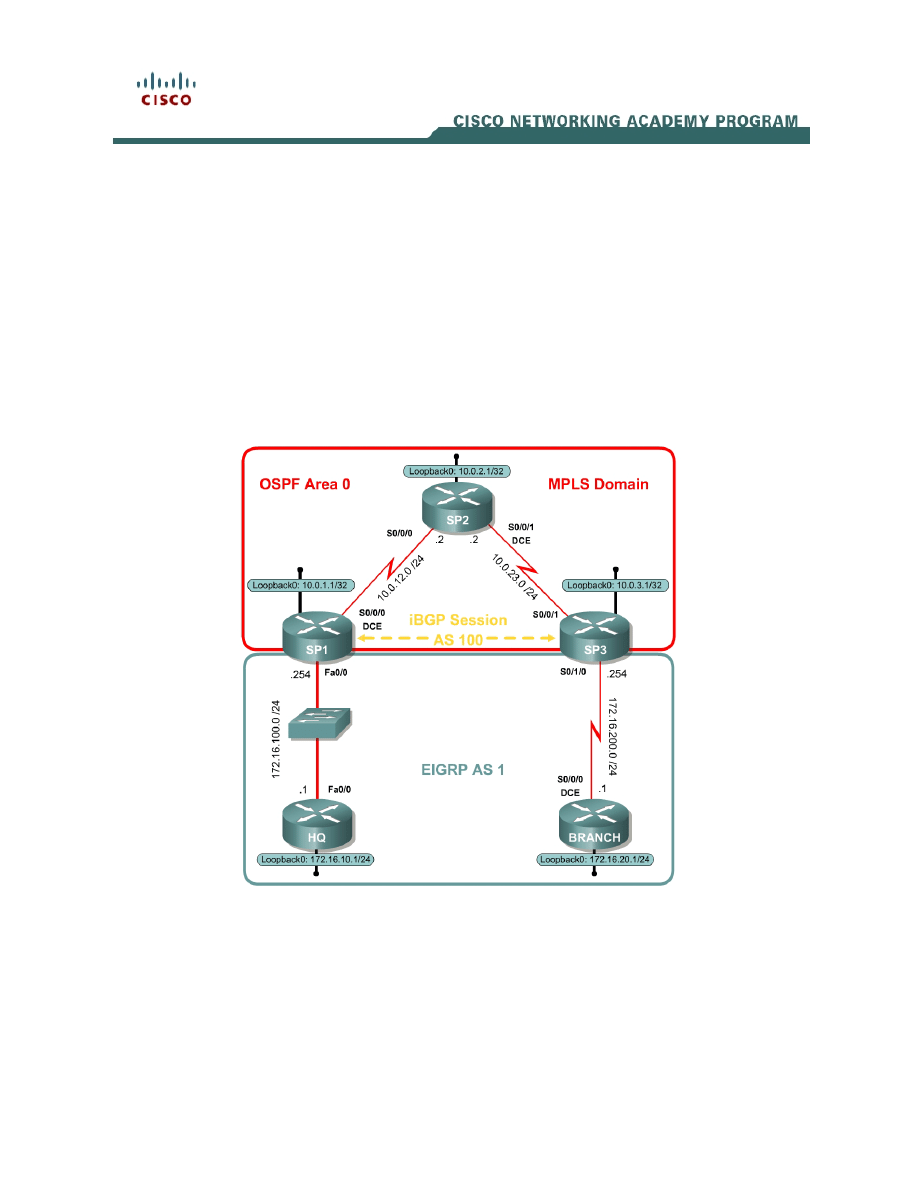
1 - 27
CCNP: Implementing Secure Converged Wide-area Networks v5.0 - Lab 4-2
Copyright
© 2007, Cisco Systems, Inc
Lab 4.2 Challenge Lab: Implementing MPLS VPNs
Learning Objectives
• Configure Open Shortest Path First (OSPF) and Enhanced Interior Gateway
Routing Protocol (EIGRP) on a router
• Enable MPLS on a router
• Verify MPLS implementation
• Configure a Virtual Routing/Forwarding (VRF) instance
• Use MBGP to exchange VPN routing updates
• Verify VPN activity
Topology Diagram
Scenario
As a network engineer at a service provider corporation, you suggest rolling out
MPLS as a new transport technology to facilitate VPNs between customer sites
that connect through your network. Your CIO has asked you to implement
proof-of-concept in a lab environment, starting with a small implementation of
MPLS VPNs before moving up to more moderately sized test cases.

MPLS VPN technology is a powerful technology that leverages the multiprotocol
aspect of MPLS to switch MPLS frames between VPN endpoints while hiding
the customer networks from the MPLS transport network that connects them. In
other words, the intermediate transport network has no knowledge of the
customer’s IP networks, but is still able to label-switch frames based on
information it receives from MPLS Label Distribution Protocol (LDP)
relationships.
You decide to model one of your current customer’s connections and then show
how MPLS VPNs can be used to carry customer traffic through the provider
network. The International Travel Agency currently uses your network to
connect from its corporate headquarters to a remote branch office, so you
choose this customer network to model in your demonstration.
First, set up the model of both the service provider’s network and the agency’s
network. Then use appropriate routing and forwarding techniques to set up an
MPLS VPN between the provider edge routers to which the customer connects.
SP1, SP2, and SP3 will represent a service provider network, and HQ and
BRANCH will represent the International Travel Agency routers at their
headquarters and at a branch site.
Step 1: Configure Addressing
Configure the loopback interfaces with the addresses shown in the diagram.
Also configure the serial interfaces shown in the diagram. Set the clock rate on
the appropriate interfaces and issue the no shutdown command on all physical
interfaces. Verify that you have connectivity across the local subnet using the
ping command inside the service provider domain. Wait to configure the
interface on SP1 facing HQ and the interface on SP3 facing BRANCH. These
will be configured later.
SP1(config)# interface loopback 0
SP1(config-if)# ip address 10.0.1.1 255.255.255.255
SP1(config-if)# interface serial 0/0/0
SP1(config-if)# ip address 10.0.12.1 255.255.255.0
SP1(config-if)# no shutdown
SP1(config-if)# interface fastethernet 0/0
SP1(config-if)# ip address 172.16.100.254 255.255.255.0
SP1(config-if)# no shutdown
SP2(config)# interface loopback 0
SP2(config-if)# ip address 10.0.2.1 255.255.255.255
SP2(config-if)# interface serial 0/0/0
SP2(config-if)# ip address 10.0.12.2 255.255.255.0
SP2(config-if)# no shutdown
SP2(config-if)# interface serial 0/0/1
SP2(config-if)# ip address 10.0.23.2 255.255.255.0
SP2(config-if)# clockrate 64000
SP2(config-if)# no shutdown
SP3(config)# interface loopback 0
SP3(config-if)# ip address 10.0.3.1 255.255.255.255
2 - 27
CCNP: Implementing Secure Converged Wide-area Networks v5.0 - Lab 4-2
Copyright
© 2007, Cisco Systems, Inc

SP3(config-if)# interface serial 0/0/1
SP3(config-if)# ip address 10.0.23.3 255.255.255.0
SP3(config-if)# no shutdown
SP3(config-if)# interface serial 0/1/0
SP3(config-if)# ip address 172.16.200.254 255.255.255.0
SP3(config-if)# no shutdown
Configure customer sites HQ and BRANCH.
HQ(config)# interface loopback 0
HQ(config-if)# ip address 172.16.10.1 255.255.255.0
HQ(config-if)# interface fastethernet 0/0
HQ(config-if)# ip address 172.16.100.1 255.255.255.0
HQ(config-if)# no shutdown
BRANCH(config)# interface loopback 0
BRANCH(config-if)# ip address 172.16.20.1 255.255.255.0
BRANCH(config-if)# interface serial 0/0/0
BRANCH(config-if)# ip address 172.16.200.1 255.255.255.0
BRANCH(config-if)# clockrate 64000
BRANCH(config-if)# no shutdown
Step 2: Configure Routing in the Service Provider Domain
Your service provider network uses OSPF as its routing protocol, advertising
internal loopback interfaces and transit networks. Configure OSPF to model the
service provider domain. Add all of the interfaces addressed within the 10.0.0.0
major network into Area 0 of the OSPF process. You will only need to configure
OSPF in this manner on the service provider routers, namely SP1, SP2, and
SP3.
SP1(config)# router ospf 1
SP1(config-router)# network 10.0.0.0 0.255.255.255 area 0
SP2(config)# router ospf 1
SP2(config-router)# network 10.0.0.0 0.255.255.255 area 0
SP3(config)# router ospf 1
SP3(config-router)# network 10.0.0.0 0.255.255.255 area 0
Verify that all of your OSPF adjacencies come up. OSPF adjacencies should
form between SP1 and SP2 and between SP2 and SP3. If the adjacencies do
not form, troubleshoot by checking your interface configuration, OSPF
configuration, and physical connectivity.
What purpose does OSPF serve in the configuration above?
3 - 27
CCNP: Implementing Secure Converged Wide-area Networks v5.0 - Lab 4-2
Copyright
© 2007, Cisco Systems, Inc

Consider that you will deploy Border Gateway Protocol (BGP) in the SP domain
later in the lab using loopback addresses as the sources for BGP updates. Why
do you need to deploy an Interior Gateway Protocol (IGP) in the SP domain?
Step 3: Configure MPLS in the SP Domain
On all the service provider routers, force MPLS to use the Loopback 0 interface
as the router ID for Label Distribution Protocol (LDP) adjacencies. The loopback
interface would be chosen by each router automatically, but it is advisable to
force the ID so that the value is persistent through topology changes and
reloads. To force LDP’s selection of the loopback interface as the router ID, use
the mpls ldp router-id interface force command in global configuration mode.
Also, enable MPLS on all of the physical interfaces in the MPLS domain with
the mpls ip command.
SP1(config)# mpls ldp router-id loopback0 force
SP1(config)# interface serial0/0/0
SP1(config-if)# mpls ip
SP2(config)# mpls ldp router-id loopback0 force
SP2(config)# interface serial0/0/0
SP2(config-if)# mpls ip
SP2(config-if)# interface serial0/0/1
SP2(config-if)# mpls ip
SP3(config)# mpls ldp router-id loopback0 force
SP3(config)# interface serial0/0/1
SP3(config-if)# mpls ip
You should see console messages notifying you that the MPLS-enabled routers
have become adjacent with each other via LDP. Verify that these adjacencies
have formed using the show mpls ldp neighbor command.
SP1# show mpls ldp neighbor
Peer LDP Ident: 10.0.2.1:0; Local LDP Ident 10.0.1.1:0
TCP connection: 10.0.2.1.62676 - 10.0.1.1.646
State: Oper; Msgs sent/rcvd: 9/9; Downstream
Up time: 00:01:43
LDP discovery sources:
Serial0/0/0, Src IP addr: 10.0.12.2
Addresses bound to peer LDP Ident:
10.0.12.2 10.0.23.2 10.0.2.1
SP2# show mpls ldp neighbor
Peer LDP Ident: 10.0.1.1:0; Local LDP Ident 10.0.2.1:0
TCP connection: 10.0.1.1.646 - 10.0.2.1.62676
State: Oper; Msgs sent/rcvd: 10/10; Downstream
Up time: 00:02:03
LDP discovery sources:
Serial0/0/0, Src IP addr: 10.0.12.1
Addresses bound to peer LDP Ident:
10.0.12.1 10.0.1.1
4 - 27
CCNP: Implementing Secure Converged Wide-area Networks v5.0 - Lab 4-2
Copyright
© 2007, Cisco Systems, Inc

Peer LDP Ident: 10.0.3.1:0; Local LDP Ident 10.0.2.1:0
TCP connection: 10.0.3.1.42919 - 10.0.2.1.646
State: Oper; Msgs sent/rcvd: 10/10; Downstream
Up time: 00:01:58
LDP discovery sources:
Serial0/0/1, Src IP addr: 10.0.23.3
Addresses bound to peer LDP Ident:
10.0.23.3 10.0.3.1
SP3# show mpls ldp neighbor
Peer LDP Ident: 10.0.2.1:0; Local LDP Ident 10.0.3.1:0
TCP connection: 10.0.2.1.646 - 10.0.3.1.42919
State: Oper; Msgs sent/rcvd: 10/10; Downstream
Up time: 00:02:08
LDP discovery sources:
Serial0/0/1, Src IP addr: 10.0.23.2
Addresses bound to peer LDP Ident:
10.0.12.2 10.0.23.2 10.0.2.1
Step 4: Configure a VRF
An MPLS VPN is a Layer 3 VPN that allows the routing of packets through a
MPLS core. This type of VPN provides a customer with connections to multiple
sites through a service provider’s network. The service provider not only
provides the physical connection, but the ability to dynamically route between
the VPN endpoints. This is especially impressive when one considers that the
customers may not be using globally unique Layer 3 addresses. For instance,
different customers can use private addresses, as defined by RFC 1918, but
still use the same transit provider to route their specific endpoints without
translation. The routers at the provider’s edge run the same routing protocol as
the customer’s network and allow the customer offices to interface with the
provider.
5 - 27
CCNP: Implementing Secure Converged Wide-area Networks v5.0 - Lab 4-2
Copyright
© 2007, Cisco Systems, Inc

The standard model for MPLS VPNs uses the following designations:
• Provider (P) — Routers owned by the SP that act as label switch routers
(LSRs) to provide transit across the provider backbone. P routers do not
carry customer routes in their routing tables.
• Customer (C) — Routers owned by the customer that provide transit
through the normal customer network.
• Customer Edge (CE) — The CE router is installed at the customer site.
Depending upon the business model of the ISP, this router may be
managed by the customer, the ISP, or both. The CE router connects to,
and communicates with, the service provider routers, and allows the
service provider to participate in customer routing.
• Provider Edge (PE) — Routers owned by the provider that actively
participate in customer routing, guaranteeing optimum routing between
customer sites. PE routers use a separate virtual routing table for each
customer, resulting in perfect isolation between customers.
It is important to note that neither the C nor the CE routers need any special
configuration. The P routers only require a simple MPLS LDP configuration.
6 - 27
CCNP: Implementing Secure Converged Wide-area Networks v5.0 - Lab 4-2
Copyright
© 2007, Cisco Systems, Inc

In this lab, SP2 models the P router, SP1 and SP3 model the PE routers. HQ
and BRANCH are both CE routers with loopback networks to simulate
connections to other C routers.
The PE routers control the entire MPLS VPN from end to end. There are a
number of relevant questions you may be asking: How can a single router
determine which routes in its table belong to the service provider’s internal
network and which routes belong to each customer? How can the PE device
allow customers to utilize existing networks including private addressing without
creating routing problems?
The answer to all of these questions lies in the ability of routers to maintain
virtual routing and forwarding (VRF) instances. Each VRF uses and maintains
its own routing information base (RIB) and Cisco Express Forwarding (CEF)
table. Interfaces are either assigned to specific VRF instances or they use the
default RIB and CEF tables. The VRF instance’s RIB fulfills the role of control
plane while the VRF’s CEF table fulfills the role of the data forwarding plane.
Routing protocols between the PE and CE routers populate the VRF RIB and
CEF makes forwarding decisions based on the routes in the VRF RIB. When an
IP packet arrives on an interface that has been associated with a VRF, the
packet is routed according to the CEF table for that VRF instance. CEF is the
only IP switching protocol supported for VRF, so CEF should be enabled
globally with the ip cef command and on the interfaces associated with the VRF
instance.
However, PE routers must now be connected through the provider network to
perform routing and forwarding between customer sites. The most efficient and
only scalable method to achieve this is to use the multiprotocol extensions to
BGP (MP-BGP) that enable it to carry routes for different routed protocols. PE
routers will establish iBGP sessions with other PEs in your carrier network to
exchange for each VPN routes. This will help populate the VRF routing tables
on each of the PE routers with the VRF tables from other customer sites. CEF
tables will be updated with the RIB information so that forwarding may occur
between customer sites once the label-switched paths have been created
through the provider network.
PE routers advertise routes that are part of their VPN using a new traffic class
to distinguish these routes from internal routes in the provider’s network. BGP
uses a new address family called VPNv4 to carry MPLS-VPN routes to IPv4
networks. The VPNv4 address family is a 12-byte address consisting of an 8-
byte route distinguisher (RD) and a 4-byte IPv4 address. The RD acts as a
unique prefix when appended with the IPv4 address. Each VRF must have an
RD for unique advertisement.
VRFs use the route target attribute to control the import and export of VPNv4
routes through iBGP. The route target is an extended BGP community that
indicates which routes should be imported from MP-BGP into the VRF.
7 - 27
CCNP: Implementing Secure Converged Wide-area Networks v5.0 - Lab 4-2
Copyright
© 2007, Cisco Systems, Inc

Exporting a route target (RT) means that the exported VPNv4 route receives an
additional BGP extended community—this is the route target—when the route
is redistributed from the VRF RIB into MP-BGP. Importing an RT means that
the received VPNv4 route from MP-BGP is checked for a matching extended
community—this is the route target—with the ones in the configuration.
To configure a VRF instance on the PE routers, use the ip vrf name command
in global configuration mode on SP1 and SP3. At the VRF configuration prompt,
create a VRF named “customer.” Each VRF instance will need a route
distinguisher and a route target. The route distinguisher and route target are
each eight bytes in length, with a colon separating four bytes on either side.
There are various conventions for allocating route distinguishers for MPLS
VPNs, the most useful of which is ASN:nn. Another popular notation is IP
address:nn. In each of these cases, ‘nn’ represents an arbitrary value assigned
by the network administrator. In this lab, use 100:1 as the route distinguisher.
The route target is also an arbitrary eight-byte value used later in BGP.
Configure a route distinguisher (RD) of 100:1 and route target (RT) of 1:100
using the commands rd ASN:nn and route-target {import | export | both}
nn:nn. In this case, you need to use the both keyword because you want PEs
to import and export from that VRF.
SP1(config)# ip vrf customer
SP1(config-vrf)# rd 100:1
SP1(config-vrf)# route-target both 1:100
SP3(config)# ip vrf customer
SP3(config-vrf)# rd 100:1
SP3(config-vrf)# route-target both 1:100
Imagine that SP1 is running MP-BGP and it receives a VPNv4 route with a
route target of 100:100. Given the above configuration, should BGP import the
route into the customer VRF routing table?
After creating the VRFs, add interfaces to the VRF using the interface-level ip
vrf forwarding name command, where name is the VRF instance name. Use
this command on the interfaces of SP1 and SP3 (the PE routers) facing the CE
routers. Add the IP address shown in the diagram to those interfaces, as well.
SP1(config)# interface fastethernet 0/0
SP1(config-if)# ip vrf forwarding customer
SP1(config-if)# ip address 172.16.100.254 255.255.255.0
SP1(config-if)# no shut
SP3(config)# interface serial 0/1/0
SP3(config-if)# ip vrf forwarding customer
8 - 27
CCNP: Implementing Secure Converged Wide-area Networks v5.0 - Lab 4-2
Copyright
© 2007, Cisco Systems, Inc

SP3(config-if)# ip address 172.16.200.254 255.255.255.0
SP3(config-if)# no shutdown
You should now be able to ping across those the PE-CE links because you
configured the other end of these links in Step 1. However, since these are not
in the default routing table, you must use the ping vrf name address command.
Since the VRF is transparent to the customer routers, you can use a traditional
ping command when you are pinging from the C and CE routers.
SP1# ping vrf customer 172.16.100.1
Type escape sequence to abort.
Sending 5, 100-byte ICMP Echos to 172.16.100.1, timeout is 2 seconds:
!!!!!
Success rate is 100 percent (5/5), round-trip min/avg/max = 1/1/4 ms
HQ# ping 172.16.100.254
Type escape sequence to abort.
Sending 5, 100-byte ICMP Echos to 172.16.100.254, timeout is 2 seconds:
!!!!!
Success rate is 100 percent (5/5), round-trip min/avg/max = 1/2/8 ms
SP3# ping vrf customer 172.16.200.1
Type escape sequence to abort.
Sending 5, 100-byte ICMP Echos to 172.16.200.1, timeout is 2 seconds:
!!!!!
Success rate is 100 percent (5/5), round-trip min/avg/max = 28/28/32 ms
BRANCH# ping 172.16.200.254
Type escape sequence to abort.
Sending 5, 100-byte ICMP Echos to 172.16.200.254, timeout is 2 seconds:
!!!!!
Success rate is 100 percent (5/5), round-trip min/avg/max = 28/28/28 ms
Step 5: Configure EIGRP AS 1
The service provider by whom you are employed uses the BGP AS 100. Your
customer, the International Travel Agency, uses the BGP AS 1. To keep the
configuration logically consistent, use the AS number 100 for EIGRP and BGP
in the provider’s network and use the AS number 1 for EIGRP and BGP in the
customer’s network. You will configure EIGRP AS 1 on the PE routers from
within the configuration of the global EIGRP AS 100.
On the customer routers, configure EIGRP AS 1 for the major network
172.16.0.0. Disable automatic summarization.
HQ(config)# router eigrp 1
HQ(config-router)# no auto-summary
HQ(config-router)# network 172.16.0.0
BRANCH(config)# router eigrp 1
BRANCH(config-router)# no auto-summary
BRANCH(config-router)# network 172.16.0.0
9 - 27
CCNP: Implementing Secure Converged Wide-area Networks v5.0 - Lab 4-2
Copyright
© 2007, Cisco Systems, Inc

Given only the information above, will EIGRP form any adjacencies
immediately?
On the PE routers, the configuration is more complex. Every IGP has a different
method of configuring a VRF for it. To implement EIGRP for VRFs, start the
EIGRP process by configuring EIGRP AS 100. Remember, this AS belongs to
the provider and is not significant to the customer. If you were using EIGRP as
the service provider’s IGP instead of OSPF, you would configure your network
statements at this point .
SP1(config)# router eigrp 100
SP3(config)# router eigrp 100
Now, to configure EIGRP for an individual VRF instance, use the command
address-family ipv4 vrf name, where name is the name of the VRF instance.
Although each VPN must be logically separate from other IPv4 address spaces
using VRF, this separation must extend not only to the routing table but to the
routing protocols as well. The address-family command creates a logical
segment of a routing protocol and its routes and adjacencies in order to
separate it from other sets of routes and adjacencies. In this case, you will
separate an EIGRP autonomous system from the EIGRP instance initiated with
the router eigrp 100 command. Networks learned via this new autonomous
system will be injected into the VRF routing table associated with the isolated
EIGRP AS. It is also important to note that these networks will not be
advertised to any neighbors in EIGRP AS 100; it is completely separate from
the rest of the EIGRP domain.
SP1(config-router)# address-family ipv4 vrf customer
SP1(config-router-af)# autonomous-system 1
SP1(config-router-af)# no auto-summary
SP1(config-router-af)# network 172.16.0.0
SP3(config-router)# address-family ipv4 vrf customer
SP3(config-router-af)# autonomous-system 1
SP3(config-router-af)# no auto-summary
SP3(config-router-af)# network 172.16.0.0
On the PE routers, display the default routing table with the show ip route
command. Notice that the PE routers do not possess any routes from the
172.16.0.0/16 major network in the default routing table. Display the VRF
routing table with the show ip route vrf name command, where name is the
VRF instance name.
SP1# show ip route
Codes: C - connected, S - static, R - RIP, M - mobile, B - BGP
10 - 27
CCNP: Implementing Secure Converged Wide-area Networks v5.0 - Lab 4-2
Copyright
© 2007, Cisco Systems, Inc

D - EIGRP, EX - EIGRP external, O - OSPF, IA - OSPF inter area
N1 - OSPF NSSA external type 1, N2 - OSPF NSSA external type 2
E1 - OSPF external type 1, E2 - OSPF external type 2
i - IS-IS, su - IS-IS summary, L1 - IS-IS level-1, L2 - IS-IS level-2
ia - IS-IS inter area, * - candidate default, U - per-user static route
o - ODR, P - periodic downloaded static route
Gateway of last resort is not set
10.0.0.0/8 is variably subnetted, 5 subnets, 2 masks
C 10.0.12.0/24 is directly connected, Serial0/0/0
O 10.0.3.1/32 [110/129] via 10.0.12.2, 05:29:59, Serial0/0/0
O 10.0.2.1/32 [110/65] via 10.0.12.2, 05:29:59, Serial0/0/0
C 10.0.1.1/32 is directly connected, Loopback0
O 10.0.23.0/24 [110/128] via 10.0.12.2, 05:29:59, Serial0/0/0
SP1# show ip route vrf customer
Routing Table: customer
Codes: C - connected, S - static, R - RIP, M - mobile, B - BGP
D - EIGRP, EX - EIGRP external, O - OSPF, IA - OSPF inter area
N1 - OSPF NSSA external type 1, N2 - OSPF NSSA external type 2
E1 - OSPF external type 1, E2 - OSPF external type 2
i - IS-IS, su - IS-IS summary, L1 - IS-IS level-1, L2 - IS-IS level-2
ia - IS-IS inter area, * - candidate default, U - per-user static route
o - ODR, P - periodic downloaded static route
Gateway of last resort is not set
172.16.0.0/24 is subnetted, 2 subnets
D 172.16.10.0 [90/156160] via 172.16.100.1, 00:03:29, FastEthernet0/0
C 172.16.100.0 is directly connected, FastEthernet0/0
SP3# show ip route
Codes: C - connected, S - static, R - RIP, M - mobile, B - BGP
D - EIGRP, EX - EIGRP external, O - OSPF, IA - OSPF inter area
N1 - OSPF NSSA external type 1, N2 - OSPF NSSA external type 2
E1 - OSPF external type 1, E2 - OSPF external type 2
i - IS-IS, su - IS-IS summary, L1 - IS-IS level-1, L2 - IS-IS level-2
ia - IS-IS inter area, * - candidate default, U - per-user static route
o - ODR, P - periodic downloaded static route
Gateway of last resort is not set
10.0.0.0/8 is variably subnetted, 5 subnets, 2 masks
O 10.0.12.0/24 [110/128] via 10.0.23.2, 05:30:42, Serial0/0/1
C 10.0.3.1/32 is directly connected, Loopback0
O 10.0.2.1/32 [110/65] via 10.0.23.2, 05:30:42, Serial0/0/1
O 10.0.1.1/32 [110/129] via 10.0.23.2, 05:30:42, Serial0/0/1
C 10.0.23.0/24 is directly connected, Serial0/0/1
SP3# show ip route vrf customer
Routing Table: customer
Codes: C - connected, S - static, R - RIP, M - mobile, B - BGP
D - EIGRP, EX - EIGRP external, O - OSPF, IA - OSPF inter area
N1 - OSPF NSSA external type 1, N2 - OSPF NSSA external type 2
E1 - OSPF external type 1, E2 - OSPF external type 2
i - IS-IS, su - IS-IS summary, L1 - IS-IS level-1, L2 - IS-IS level-2
ia - IS-IS inter area, * - candidate default, U - per-user static route
o - ODR, P - periodic downloaded static route
Gateway of last resort is not set
11 - 27
CCNP: Implementing Secure Converged Wide-area Networks v5.0 - Lab 4-2
Copyright
© 2007, Cisco Systems, Inc

172.16.0.0/24 is subnetted, 2 subnets
C 172.16.200.0 is directly connected, Serial0/1/0
D 172.16.20.0 [90/2297856] via 172.16.200.1, 00:02:06, Serial0/1/0
The SP1 and HQ routers do not possess routes to the customer networks on
SP3 and BRANCH and vice versa. Explain why this occurs though EIGRP
adjacencies have formed:
Step 6: Configure BGP
Now that the PE routers are routing to the CE routers over VRF tables, you can
set up the PE routers to exchange routes through BGP. First, configure BGP
between SP1 and SP3 and have them peer between their loopback addresses.
Synchronization should be disabled by default on newer IOS releases. If
synchronization is not already disabled, then explicitly disable it using the no
synchronization command. For more information on configuring BGP, refer to
CCNP1.
SP1(config)# router bgp 100
SP1(config-router)# neighbor 10.0.3.1 remote-as 100
SP1(config-router)# neighbor 10.0.3.1 update-source loopback0
SP3(config)# router bgp 100
SP3(config-router)# neighbor 10.0.1.1 remote-as 100
SP3(config-router)# neighbor 10.0.1.1 update-source loopback0
To configure the exchange of VPNv4 routes over BGP, use the address-family
vpnv4 command. At the address family prompt, activate the BGP neighbor for
this address family with neighbor address activate command. Activating a
neighbor for an address family allows BGP to send routes to and receive routes
from the designated neighbor using the specified address family. By default,
neighbors are only activated for IPv4.
The RTs are translated as extended BGP communities, so you must allow SP1
and SP3 to send both standard and extended communities over MP-BGP using
the neighbor address send-community both command. The adjacencies may
flap (temporarily go down and then come back up) when you activate the
address family.
SP1(config-router)# address-family vpnv4
SP1(config-router-af)# neighbor 10.0.3.1 activate
SP1(config-router-af)# neighbor 10.0.3.1 send-community both
SP1(config-router-af)# exit
SP3(config-router)# address-family vpnv4
SP3(config-router-af)# neighbor 10.0.1.1 activate
12 - 27
CCNP: Implementing Secure Converged Wide-area Networks v5.0 - Lab 4-2
Copyright
© 2007, Cisco Systems, Inc

SP3(config-router-af)# neighbor 10.0.1.1 send-community both
SP3(config-router-af)# exit
Finally, you need to configure BGP to redistribute the EIGRP routes in the VRF
RIB into the BGP protocol so that these are advertised to the remote PE. Under
the main BGP configuration prompt, enter another address family associated
only with the routing table for the VRF customer. Redistribute the EIGRP routes
that are associated with this VRF into BGP.
SP1(config-router)# address-family ipv4 vrf customer
SP1(config-router-af)# redistribute eigrp 1
SP1(config-router-af)# exit
SP1(config-router)# exit
SP3(config-router)# address-family ipv4 vrf customer
SP3(config-router-af)# redistribute eigrp 1
SP3(config-router-af)# exit
SP3(config-router)# exit
Based on the above configuration, will SP1’s VRF RIB contain the
172.16.20.0/24 route that was originated by EIGRP on BRANCH? Explain.
Will HQ learn the same routes via EIGRP? Explain.
Do you expect to see the redistributed routes as internal or external EIGRP
routes on the CE routers? Explain.
Enter the EIGRP instance that contains the VRF configuration on SP1 and SP3
and configure it to redistribute BGP routes. Since you are redistributing into
EIGRP from BGP, the metrics are not comparable. Add a seed metric with a
bandwidth of 64 kbps, 100 microseconds, reliability of 255/255, load of 1/255,
and MTU of 1500 bytes.
SP1(config)# router eigrp 100
13 - 27
CCNP: Implementing Secure Converged Wide-area Networks v5.0 - Lab 4-2
Copyright
© 2007, Cisco Systems, Inc

SP1(config-router)# address-family ipv4 vrf customer
SP1(config-router-af)# redistribute bgp 100 metric 64 1000 255 1 1500
SP3(config)# router eigrp 100
SP3(config-router)# address-family ipv4 vrf customer
SP3(config-router-af)# redistribute bgp 100 metric 64 1000 255 1 1500
Step 7: Investigate Control Plane Operation
Remember that MPLS differentiates the control plane from the forwarding
plane. The control plane, represented by the routing table (the RIB) and the
routing protocols, must operate so that the VRF routes reach remote PEs and
are installed as necessary in the VRF routing tables. Not only the prefixes, but
also the accompanying metrics and tags are important to the reconstruction of
the route at the remote PE. Fortunately, MP-BGP allows you to send these
metrics in the Network Layer Reachability Information (NLRI).
Through this step and also Step 8, you will investigate the routing and
forwarding information associated with the route to 172.16.20.0/24.
Verify that the routes have propagated to the remote PE routers. Issue the
show ip route vrf name command to see the VRF RIB. Notice the source of
the routes on the PE routers.
SP1# show ip route vrf customer
Routing Table: customer
Codes: C - connected, S - static, R - RIP, M - mobile, B - BGP
D - EIGRP, EX - EIGRP external, O - OSPF, IA - OSPF inter area
N1 - OSPF NSSA external type 1, N2 - OSPF NSSA external type 2
E1 - OSPF external type 1, E2 - OSPF external type 2
i - IS-IS, su - IS-IS summary, L1 - IS-IS level-1, L2 - IS-IS level-2
ia - IS-IS inter area, * - candidate default, U - per-user static route
o - ODR, P - periodic downloaded static route
Gateway of last resort is not set
172.16.0.0/24 is subnetted, 4 subnets
B 172.16.200.0 [200/0] via 10.0.3.1, 00:06:44
B 172.16.20.0 [200/2297856] via 10.0.3.1, 00:06:44
D 172.16.10.0 [90/156160] via 172.16.100.1, 00:17:34, FastEthernet0/0
C 172.16.100.0 is directly connected, FastEthernet0/0
SP3# show ip route vrf customer
Routing Table: customer
Codes: C - connected, S - static, R - RIP, M - mobile, B - BGP
D - EIGRP, EX - EIGRP external, O - OSPF, IA - OSPF inter area
N1 - OSPF NSSA external type 1, N2 - OSPF NSSA external type 2
E1 - OSPF external type 1, E2 - OSPF external type 2
i - IS-IS, su - IS-IS summary, L1 - IS-IS level-1, L2 - IS-IS level-2
ia - IS-IS inter area, * - candidate default, U - per-user static route
o - ODR, P - periodic downloaded static route
Gateway of last resort is not set
172.16.0.0/24 is subnetted, 4 subnets
C 172.16.200.0 is directly connected, Serial0/1/0
14 - 27
CCNP: Implementing Secure Converged Wide-area Networks v5.0 - Lab 4-2
Copyright
© 2007, Cisco Systems, Inc

D 172.16.20.0 [90/2297856] via 172.16.200.1, 16:47:37, Serial0/1/0
B 172.16.10.0 [200/156160] via 10.0.1.1, 00:17:28
B 172.16.100.0 [200/0] via 10.0.1.1, 00:17:28
You may be asking “Why does the source of the route to 172.16.20.0/24 on
SP1 point to 10.0.3.1 since that address would be routed based on the default
routing table?” Consider that when an internally generated route is sent to an
iBGP peer, BGP sets the NEXT-HOP attribute to be the advertising router. In
this case, SP3 generates the route in BGP by redistribution. The BGP peers are
communicating between loopback interfaces, so the NEXT-HOP is set to the IP
address of the BGP peer’s source interface. The VRF RIB thus points to an
interface that must be reached through the default, global RIB. We will
investigate the forwarding for packets destined for these networks in the next
step.
On the CE routers, issue the show ip route command to see a full routing
table.
HQ# show ip route
Codes: C - connected, S - static, R - RIP, M - mobile, B - BGP
D - EIGRP, EX - EIGRP external, O - OSPF, IA - OSPF inter area
N1 - OSPF NSSA external type 1, N2 - OSPF NSSA external type 2
E1 - OSPF external type 1, E2 - OSPF external type 2, E - EGP
i - IS-IS, su - IS-IS summary, L1 - IS-IS level-1, L2 - IS-IS level-2
ia - IS-IS inter area, * - candidate default, U - per-user static route
o - ODR, P - periodic downloaded static route
Gateway of last resort is not set
172.16.0.0/24 is subnetted, 4 subnets
D 172.16.200.0
[90/2172416] via 172.16.100.254, 00:05:17, FastEthernet0/0
D 172.16.20.0 [90/2300416] via 172.16.100.254, 00:05:17, FastEthernet0/0
C 172.16.10.0 is directly connected, Loopback0
C 172.16.100.0 is directly connected, FastEthernet0/0
BRANCH# show ip route
Codes: C - connected, S - static, R - RIP, M - mobile, B - BGP
D - EIGRP, EX - EIGRP external, O - OSPF, IA - OSPF inter area
N1 - OSPF NSSA external type 1, N2 - OSPF NSSA external type 2
E1 - OSPF external type 1, E2 - OSPF external type 2
i - IS-IS, su - IS-IS summary, L1 - IS-IS level-1, L2 - IS-IS level-2
ia - IS-IS inter area, * - candidate default, U - per-user static route
o - ODR, P - periodic downloaded static route
Gateway of last resort is not set
172.16.0.0/24 is subnetted, 4 subnets
C 172.16.200.0 is directly connected, Serial0/0/0
C 172.16.20.0 is directly connected, Loopback0
D 172.16.10.0 [90/2300416] via 172.16.200.254, 00:02:02, Serial0/0/0
D 172.16.100.0 [90/2172416] via 172.16.200.254, 00:02:02, Serial0/0/0
On both the CE and PE routers, notice that the routes you redistributed from
BGP into EIGRP are internal EIGRP routes because BGP preserves features of
the EIGRP route while advertising the route to the other PEs. The PE encodes
as much EIGRP information as possible into new extended communities TLV
15 - 27
CCNP: Implementing Secure Converged Wide-area Networks v5.0 - Lab 4-2
Copyright
© 2007, Cisco Systems, Inc

tuples (type, length, value) to preserve route characteristics through the VPN.
This enables the remote PE router to reconstruct the EIGRP route with all of its
characteristics, including the metric components, AS, TAG and, for external
routes, the remote AS number, the remote ID, the remote protocol, and the
remote metric. These are the EIGRP characteristics of a prefix that you can find
in the topology table. If the EIGRP-advertised route is internal, the route is
advertised as an internal route into the remote site if the destination AS
matches the source AS carried by the BGP extended community attributes.
Display information on the VPNv4 BGP routes on SP1 with the show bgp
vpnv4 unicast all command.
SP1# show bgp vpnv4 unicast all
BGP table version is 9, local router ID is 10.0.1.1
Status codes: s suppressed, d damped, h history, * valid, > best, i -
internal,
r RIB-failure, S Stale
Origin codes: i - IGP, e - EGP, ? - incomplete
Network Next Hop Metric LocPrf Weight Path
Route Distinguisher: 100:1 (default for vrf customer)
*> 172.16.10.0/24 172.16.100.1 156160 32768 ?
*>i172.16.20.0/24 10.0.3.1 2297856 100 0 ?
*> 172.16.100.0/24 0.0.0.0 0 32768 ?
*>i172.16.200.0/24 10.0.3.1 0 100 0 ?
SP3# show bgp vpnv4 unicast all
BGP table version is 9, local router ID is 10.0.3.1
Status codes: s suppressed, d damped, h history, * valid, > best, i -
internal,
r RIB-failure, S Stale
Origin codes: i - IGP, e - EGP, ? - incomplete
Network Next Hop Metric LocPrf Weight Path
Route Distinguisher: 100:1 (default for vrf customer)
*>i172.16.10.0/24 10.0.1.1 156160 100 0 ?
*> 172.16.20.0/24 172.16.200.1 2297856 32768 ?
*>i172.16.100.0/24 10.0.1.1 0 100 0 ?
*> 172.16.200.0/24 0.0.0.0 0 32768 ?
Notice that the metric (MED value) in BGP is the metric advertised through
EIGRP for that route as well.
What does the value of the NEXT-HOP attribute for the 172.16.200.0/24
network on SP3 indicate?
What is the value of the BGP NEXT-HOP attribute for the 172.16.20.0/24 route
on SP1?
16 - 27
CCNP: Implementing Secure Converged Wide-area Networks v5.0 - Lab 4-2
Copyright
© 2007, Cisco Systems, Inc

By which routing protocol and from which router was the route to 10.0.3.1/32
installed in the default routing table on SP1?
View more specific detail on a particular prefix using show bgp vpnv4 unicast
all ip-address command. Notice that the MPLS label information is included.
Execute this on both of the PEs. Remember that SP3 is advertising the
172.16.20.0/24 prefix through BGP, while SP1 is receiving the route through
BGP NLRI.
SP1# show bgp vpnv4 unicast all 172.16.20.0/24
BGP routing table entry for 100:1:172.16.20.0/24, version 15
Paths: (1 available, best #1, table customer)
Flag: 0x820
Not advertised to any peer
Local
10.0.3.1 (metric 129) from 10.0.3.1 (10.0.3.1)
Origin incomplete, metric 2297856, localpref 100, valid, internal, best
Extended Community: RT:1:100
Cost:pre-bestpath:128:2297856 (default-2145185791) 0x8800:32768:0
0x8801:1:640000 0x8802:65281:1657856 0x8803:65281:1500
mpls labels in/out nolabel/20
SP3# show bgp vpnv4 unicast all 172.16.20.1
BGP routing table entry for 100:1:172.16.20.0/24, version 15
Paths: (1 available, best #1, table customer)
Advertised to update-groups:
1
Local
172.16.200.1 from 0.0.0.0 (10.0.3.1)
Origin incomplete, metric 2297856, localpref 100, weight 32768, valid,
sourced, best
Extended Community: RT:1:100
Cost:pre-bestpath:128:2297856 (default-2145185791) 0x8800:32768:0
0x8801:1:640000 0x8802:65281:1657856 0x8803:65281:1500
mpls labels in/out 20/nolabel
Notice that there are multiple values in the BGP extended communities. Recall
that BGP sends the route information in NLRI as extended communities. These
values are TLVs indicating such EIGRP attributes as the TAG, AS number,
bandwidth, delay, reliability, load, MTU, and hop count.
Why is the origin code “incomplete”?
17 - 27
CCNP: Implementing Secure Converged Wide-area Networks v5.0 - Lab 4-2
Copyright
© 2007, Cisco Systems, Inc

What type of attribute carries the route target information in MP-BGP NLRI?
Notice the MPLS labels indicated for the BGP route above. The in-label of
‘nolabel’ on SP1 indicates that SP1 is not advertising a label for the prefix
172.16.20.0/24. The out-label of 21 is advertised by SP3 and received by SP1.
This label is significant only on the path between SP1 and SP3. This label has
been allocated by BGP on SP3.
View the list of MPLS labels that are being used with BGP using show bgp
vpnv4 unicast all labels.
SP1# show bgp vpnv4 unicast all labels
Network Next Hop In label/Out label
Route Distinguisher: 100:1 (customer)
172.16.10.0/24 172.16.100.1 19/nolabel
172.16.20.0/24 10.0.3.1 nolabel/20
172.16.100.0/24 0.0.0.0 20/aggregate(customer)
172.16.200.0/24 10.0.3.1 nolabel/19
SP3# show bgp vpnv4 unicast all labels
Network Next Hop In label/Out label
Route Distinguisher: 100:1 (customer)
172.16.10.0/24 10.0.1.1 nolabel/19
172.16.20.0/24 172.16.200.1 20/nolabel
172.16.100.0/24 10.0.1.1 nolabel/20
172.16.200.0/24 0.0.0.0 19/aggregate(customer)
How has SP1 learned the VPN label, label 20?
Will SP1 or SP2 learn the label via LDP?
Has the P router SP3 learned about label 20 from SP3? Explain.
18 - 27
CCNP: Implementing Secure Converged Wide-area Networks v5.0 - Lab 4-2
Copyright
© 2007, Cisco Systems, Inc

Finally, display the route attributes for the same prefix, 172.16.20.0/24, in the
EIGRP topology table on SP1 with the show ip eigrp vrf customer topology
ip-prefix/mask command. Verify this against the originator of the EIGRP route in
BGP, SP3.
SP1# show ip eigrp vrf customer topology 172.16.20.0/24
IP-EIGRP (AS 1): Topology entry for 172.16.20.0/24
State is Passive, Query origin flag is 1, 1 Successor(s), FD is 2297856
Routing Descriptor Blocks:
10.0.3.1, from VPNv4 Sourced, Send flag is 0x0
Composite metric is (2297856/0), Route is Internal (VPNv4 Sourced)
Vector metric:
Minimum bandwidth is 1544 Kbit
Total delay is 25000 microseconds
Reliability is 255/255
Load is 1/255
Minimum MTU is 1500
Hop count is 1
SP3# show ip eigrp vrf customer topology 172.16.20.0/24
IP-EIGRP (AS 1): Topology entry for 172.16.20.0/24
State is Passive, Query origin flag is 1, 1 Successor(s), FD is 2297856
Routing Descriptor Blocks:
172.16.200.1 (Serial0/1/0), from 172.16.200.1, Send flag is 0x0
Composite metric is (2297856/128256), Route is Internal
Vector metric:
Minimum bandwidth is 1544 Kbit
Total delay is 25000 microseconds
Reliability is 255/255
Load is 1/255
Minimum MTU is 1500
Hop count is 1
Notice that there is absolutely no difference in the EIGRP route parameters
between SP1 and SP3. BGP encodes and decodes the information on the PE
routers with no changes.
Remember that SP2, a P router, has no knowledge of individual routes in the
VRF tables on the PE routers. You can verify this with the show commands
performed previously.
SP2# show ip route
Codes: C - connected, S - static, R - RIP, M - mobile, B - BGP
D - EIGRP, EX - EIGRP external, O - OSPF, IA - OSPF inter area
N1 - OSPF NSSA external type 1, N2 - OSPF NSSA external type 2
E1 - OSPF external type 1, E2 - OSPF external type 2
i - IS-IS, su - IS-IS summary, L1 - IS-IS level-1, L2 - IS-IS level-2
ia - IS-IS inter area, * - candidate default, U - per-user static route
o - ODR, P - periodic downloaded static route
Gateway of last resort is not set
19 - 27
CCNP: Implementing Secure Converged Wide-area Networks v5.0 - Lab 4-2
Copyright
© 2007, Cisco Systems, Inc

10.0.0.0/8 is variably subnetted, 5 subnets, 2 masks
C 10.0.12.0/24 is directly connected, Serial0/0/0
O 10.0.3.1/32 [110/65] via 10.0.23.3, 1d00h, Serial0/0/1
C 10.0.2.1/32 is directly connected, Loopback0
O 10.0.1.1/32 [110/65] via 10.0.12.1, 1d00h, Serial0/0/0
C 10.0.23.0/24 is directly connected, Serial0/0/1
SP2# show ip route vrf customer
% IP routing table customer does not exist
Ping between the CE routers to verify connectivity through the MPLS VPN.
HQ# ping 172.16.20.1
Type escape sequence to abort.
Sending 5, 100-byte ICMP Echos to 172.16.20.1, timeout is 2 seconds:
!!!!!
Success rate is 100 percent (5/5), round-trip min/avg/max = 84/89/93 ms
BRANCH# ping 172.16.10.1
Type escape sequence to abort.
Sending 5, 100-byte ICMP Echos to 172.16.10.1, timeout is 2 seconds:
!!!!!
Success rate is 100 percent (5/5), round-trip min/avg/max = 84/86/88 ms
Step 8: Investigate Forwarding Plane Operation
Recall that MPLS has two tables, the Label Information Base (LIB) and the
Label Forwarding Information Base (LFIB). Normally, LDP-allocated labels are
advertised to LDP peers. BGP-allocated labels are advertised to BGP peers.
BGP-allocated labels will be used by BGP peers as an MPLS label on packets
destined for that network through the VPN. The BGP-allocated labels are only
significant to the ingress and egress routers. P routers that are not BGP peers
with the PE routers will not see the VPN label for the networks known by BGP.
In order to traverse the MPLS cloud, the packets need to be label-switched at
every hop based on advertised labels. In order to ensure that VPN packets that
reach the egress PE have the MPLS label needed to switch the packets once
they arrive, the labels are stacked at the ingress PE. However, the packet still
needs to be sent along the label-switched path.
Recall that the VRF RIB’s next hop for the networks known via the VPN point to
the loopback on the egress PE. CEF uses the ‘inuse’ label for the BGP next hop
as the outermost label for packets traveling through the MPLS VPN. First,
however, CEF must push on the VPN label that will be used at the egress PE.
Thus, CEF stacks the label in a sequential manner so that the VPN label is
available at the egress PE, but the label to traverse the label-switched path
through the P routers is pushed as the outermost label.
Take some time to study and understand the details of how this is possible.
BGP, LDP, CEF, the LFIB, and the provider’s IGP are all involved in the use of
MPLS labels as a VPN technology.
20 - 27
CCNP: Implementing Secure Converged Wide-area Networks v5.0 - Lab 4-2
Copyright
© 2007, Cisco Systems, Inc

Once BGP learns the MPLS label to use as the VPN label, this information is
entered into the CEF forwarding table on the ingress PE. Display the CEF
forwarding entry for 172.16.20.0/24 on SP1 with the show ip cef vrf name ip-
address command.
SP1# show ip cef vrf customer 172.16.20.0
172.16.20.0/24, version 12, epoch 0, cached adjacency to Serial0/0/0
0 packets, 0 bytes
tag information set
local tag: VPN-route-head
fast tag rewrite with Se0/0/0, point2point, tags imposed: {16 20}
via 10.0.3.1, 0 dependencies, recursive
next hop 10.0.12.2, Serial0/0/0 via 10.0.3.1/32
valid cached adjacency
tag rewrite with Se0/0/0, point2point, tags imposed: {16 20}
CEF resolves the recursive lookup to the BGP next hop. Based on the labels
learned by LDP, CEF may or may not apply the forwarding label to reach
10.0.3.1/32. In this case, LDP on SP2 has advertised a forwarding label to SP1.
View the labels advertised to SP1 via LDP using the show mpls ip binding
command.
SP1# show mpls ip binding
10.0.1.1/32
in label: imp-null
out label: 17 lsr: 10.0.2.1:0
10.0.2.1/32
in label: 16
out label: imp-null lsr: 10.0.2.1:0 inuse
10.0.3.1/32
in label: 17
out label: 16 lsr: 10.0.2.1:0 inuse
10.0.12.0/24
in label: imp-null
out label: imp-null lsr: 10.0.2.1:0
10.0.23.0/24
in label: 18
out label: imp-null lsr: 10.0.2.1:0 inuse
CEF pushes the label of 20 onto the packet first, then pushes the outer label of
16. The CEF forwarding table decides which path to use based of course on the
default RIB. The route has been installed in the RIB by OSPF. Thus, the ingress
PE imposes two labels in the sequence {16, 20} as shown in the CEF
forwarding table above.
Since the incoming VPN packets from SP1 are encapsulated in MPLS frames,
SP2 acts according to the directives in its LFIB. SP2 is also the penultimate hop
in the label-switched path from SP1 to SP3’s loopback interface, and therefore
pops the outermost label from the MPLS frame. Display the LFIB with the show
mpls forwarding-table command.
SP2# show mpls forwarding-table
Local Outgoing Prefix Bytes tag Outgoing Next Hop
tag tag or VC or Tunnel Id switched interface
16 Pop tag 10.0.3.1/32 5175 Se0/0/1 point2point
17 Pop tag 10.0.1.1/32 8079 Se0/0/0 point2point
21 - 27
CCNP: Implementing Secure Converged Wide-area Networks v5.0 - Lab 4-2
Copyright
© 2007, Cisco Systems, Inc

Notice that the LFIB does not care whether there is an inner label or not, it
simply performs the operation specified in the column labeled “Outgoing tag or
VC.”
If you enable MPLS packet debugging on SP2 using debug mpls packets then
issue a ping from one CE to the other, you can see the MPLS packets being
label-switched. The ICMP packets are forwarded inside MPLS frames through
SP2. Notice in the debug output that each ICMP echo request receives a reply
which is label-switched on its return path through the MPLS network. When you
are done, disable debugging.
SP2# debug mpls packets
MPLS packet debugging is on
HQ# ping 172.16.20.1
Type escape sequence to abort.
Sending 5, 100-byte ICMP Echos to 172.16.20.1, timeout is 2 seconds:
!!!!!
Success rate is 100 percent (5/5), round-trip min/avg/max = 84/87/92 ms
SP2#
*Feb 3 20:55:57.422: MPLS: Se0/0/0: recvd: CoS=0, TTL=254, Label(s)=16/20
*Feb 3 20:55:57.422: MPLS: Se0/0/1: xmit: CoS=0, TTL=253, Label(s)=20
!
! These 2 messages indicate the label-switching of the ICMP echo request
!
*Feb 3 20:55:57.478: MPLS: Se0/0/1: recvd: CoS=0, TTL=254, Label(s)=17/20
*Feb 3 20:55:57.478: MPLS: Se0/0/0: xmit: CoS=0, TTL=253, Label(s)=20
!
! These 2 messages indicate the label-switching of the ICMP echo reply
!
*Feb 3 20:55:57.510: MPLS: Se0/0/0: recvd: CoS=0, TTL=254, Label(s)=16/20
*Feb 3 20:55:57.510: MPLS: Se0/0/1: xmit: CoS=0, TTL=253, Label(s)=20
*Feb 3 20:55:57.566: MPLS: Se0/0/1: recvd: CoS=0, TTL=254, Label(s)=17/20
*Feb 3 20:55:57.566: MPLS: Se0/0/0: xmit: CoS=0, TTL=253, Label(s)=20
*Feb 3 20:55:57.598: MPLS: Se0/0/0: recvd: CoS=0, TTL=254, Label(s)=16/20
*Feb 3 20:55:57.598: MPLS: Se0/0/1: xmit: CoS=0, TTL=253, Label(s)=20
*Feb 3 20:55:57.654: MPLS: Se0/0/1: recvd: CoS=0, TTL=254, Label(s)=17/20
*Feb 3 20:55:57.654: MPLS: Se0/0/0: xmit: CoS=0, TTL=253, Label(s)=20
*Feb 3 20:55:57.686: MPLS: Se0/0/0: recvd: CoS=0, TTL=254, Label(s)=16/20
*Feb 3 20:55:57.686: MPLS: Se0/0/1: xmit: CoS=0, TTL=253, Label(s)=20
*Feb 3 20:55:57.742: MPLS: Se0/0/1: recvd: CoS=0, TTL=254, Label(s)=17/20
*Feb 3 20:55:57.742: MPLS: Se0/0/0: xmit: CoS=0, TTL=253, Label(s)=20
*Feb 3 20:55:57.774: MPLS: Se0/0/0: recvd: CoS=0, TTL=254, Label(s)=16/20
*Feb 3 20:55:57.774: MPLS: Se0/0/1: xmit: CoS=0, TTL=253, Label(s)=20
*Feb 3 20:55:57.830: MPLS: Se0/0/1: recvd: CoS=0, TTL=254, Label(s)=17/20
*Feb 3 20:55:57.830: MPLS: Se0/0/0: xmit: CoS=0, TTL=253, Label(s)=20
SP2# undebug all
All possible debugging has been turned off
Continue tracing the label-switched path through the provider network to the
egress PE, SP3.
Based on which forwarding table will the VPN packet be switched at SP3?
Explain.
22 - 27
CCNP: Implementing Secure Converged Wide-area Networks v5.0 - Lab 4-2
Copyright
© 2007, Cisco Systems, Inc

Display the MPLS LFIB on SP3 using the show mpls forwarding-table
command that you used on SP2 previously.
SP3# show mpls forwarding-table
Local Outgoing Prefix Bytes tag Outgoing Next Hop
tag tag or VC or Tunnel Id switched interface
16 Pop tag 10.0.12.0/24 0 Se0/0/1 point2point
17 Pop tag 10.0.2.1/32 0 Se0/0/1 point2point
18 17 10.0.1.1/32 0 Se0/0/1 point2point
19 Aggregate 172.16.200.0/24[V] \
2704
20 Untagged 172.16.20.0/24[V] 2704 Se0/1/0 point2point
Notice that SP3 forwards the decapsulated IP packet untagged to the Serial
0/1/0 egress interface because it was received with a label of 20. This is the
label that BGP advertised to SP1. SP1’s CEF forwarding table encapsulated the
IP packets within two MPLS labels {16 20} and then forwarded the packet to
SP2.
Conclusion
Issue the traceroute command from one CE to another to find that it is going
through multiple Layer 3 hops. This is an important debugging tool because it
can also be issued from a PE router with reference to a VRF.
HQ# traceroute 172.16.20.1
Type escape sequence to abort.
Tracing the route to 172.16.20.1
1 172.16.100.254 0 msec 0 msec 0 msec
2 10.0.12.2 126 msec 117 msec 126 msec
3 172.16.200.254 59 msec 50 msec 50 msec
4 172.16.200.1 50 msec 42 msec *
Fill in the following table tracing the path of packets from 172.16.100.1 to
172.16.20.1 in order to trace the packet’s path:
Router
Incoming
(MPLS/IP)
Outgoing
(MPLS/IP)
Switched By
(CEF/LFIB)
Incoming
Label(s)
Outgoing
Label(s)
23 - 27
CCNP: Implementing Secure Converged Wide-area Networks v5.0 - Lab 4-2
Copyright
© 2007, Cisco Systems, Inc

HQ
SP1
SP2
SP3
BRANCH
Given the output shown below on each of the routers, trace the return path from
172.16.20.1 to 172.16.100.1 by filling in the chart.
BRANCH# show ip cef 172.16.100.1
172.16.100.0/24, version 22, epoch 0, cached adjacency to Serial0/0/0
0 packets, 0 bytes
via 172.16.200.254, Serial0/0/0, 0 dependencies
next hop 172.16.200.254, Serial0/0/0
valid cached adjacency
SP3# show ip cef vrf customer 172.16.100.1
172.16.100.0/24, version 6, epoch 0, cached adjacency to Serial0/0/1
0 packets, 0 bytes
tag information set
local tag: VPN-route-head
fast tag rewrite with Se0/0/1, point2point, tags imposed: {17 20}
via 10.0.1.1, 0 dependencies, recursive
next hop 10.0.23.2, Serial0/0/1 via 10.0.1.1/32
valid cached adjacency
tag rewrite with Se0/0/1, point2point, tags imposed: {17 20}
SP2# show mpls forwarding-table
Local Outgoing Prefix Bytes tag Outgoing Next Hop
tag tag or VC or Tunnel Id switched interface
16 Pop tag 10.0.3.1/32 15601 Se0/0/1 point2point
17 Pop tag 10.0.1.1/32 25413 Se0/0/0 point2point
SP1# show mpls forwarding-table
Local Outgoing Prefix Bytes tag Outgoing Next Hop
tag tag or VC or Tunnel Id switched interface
16 Pop tag 10.0.2.1/32 0 Se0/0/0 point2point
17 16 10.0.3.1/32 0 Se0/0/0 point2point
18 Pop tag 10.0.23.0/24 0 Se0/0/0 point2point
19 Untagged 172.16.10.0/24[V] 0 Fa0/0 172.16.100.1
20 Aggregate 172.16.100.0/24[V] \0
Router
Incoming
(MPLS/IP)
Outgoing
(MPLS/IP)
Switched By
(CEF/LFIB)
Incoming
Label(s)
Outgoing
Label(s)
BRANCH
SP3
24 - 27
CCNP: Implementing Secure Converged Wide-area Networks v5.0 - Lab 4-2
Copyright
© 2007, Cisco Systems, Inc

SP2
SP1
HQ
Final Configurations
HQ# show run
hostname HQ
!
interface Loopback0
ip address 172.16.10.1 255.255.255.0
no shutdown
!
interface FastEthernet0/0
ip address 172.16.100.1 255.255.255.0
no shutdown
!
router eigrp 1
network 172.16.0.0
no auto-summary
end
SP1# show run
hostname SP1
!
ip vrf customer
rd 100:1
route-target export 1:100
route-target import 1:100
!
interface Loopback0
ip address 10.0.1.1 255.255.255.255
!
interface FastEthernet0/0
ip vrf forwarding customer
ip address 172.16.100.254 255.255.255.0
no shutdown
!
interface Serial0/0/0
ip address 10.0.12.1 255.255.255.0
mpls ip
clock rate 64000
no shutdown
!
router eigrp 100
no auto-summary
!
address-family ipv4 vrf customer
redistribute bgp 100 metric 64 1000 255 1 1500
network 172.16.0.0
no auto-summary
autonomous-system 1
exit-address-family
!
router ospf 1
network 10.0.0.0 0.255.255.255 area 0
25 - 27
CCNP: Implementing Secure Converged Wide-area Networks v5.0 - Lab 4-2
Copyright
© 2007, Cisco Systems, Inc

!
router bgp 100
no synchronization
neighbor 10.0.3.1 remote-as 100
neighbor 10.0.3.1 update-source Loopback0
no auto-summary
!
address-family vpnv4
neighbor 10.0.3.1 activate
neighbor 10.0.3.1 send-community both
exit-address-family
!
address-family ipv4 vrf customer
redistribute eigrp 1
no synchronization
exit-address-family
!
mpls ldp router-id Loopback0 force
end
SP2# show run
hostname SP2
!
interface Loopback0
ip address 10.0.2.1 255.255.255.255
!
interface Serial0/0/0
ip address 10.0.12.2 255.255.255.0
mpls ip
no shutdown
!
interface Serial0/0/1
ip address 10.0.23.2 255.255.255.0
mpls ip
clock rate 64000
no shutdown
!
router ospf 1
network 10.0.0.0 0.255.255.255 area 0
!
mpls ldp router-id Loopback0 force
end
SP3# show run
hostname SP3
!
ip vrf customer
rd 100:1
route-target export 1:100
route-target import 1:100
!
interface Loopback0
ip address 10.0.3.1 255.255.255.255
!
interface Serial0/0/1
ip address 10.0.23.3 255.255.255.0
mpls ip
no shutdown
!
interface Serial0/1/0
ip vrf forwarding customer
ip address 172.16.200.254 255.255.255.0
no shutdown
26 - 27
CCNP: Implementing Secure Converged Wide-area Networks v5.0 - Lab 4-2
Copyright
© 2007, Cisco Systems, Inc

!
router eigrp 100
no auto-summary
!
address-family ipv4 vrf customer
redistribute bgp 100 metric 64 1000 255 1 1500
network 172.16.0.0
no auto-summary
autonomous-system 1
exit-address-family
!
router ospf 1
network 10.0.0.0 0.255.255.255 area 0
!
router bgp 100
no synchronization
neighbor 10.0.1.1 remote-as 100
neighbor 10.0.1.1 update-source Loopback0
no auto-summary
!
address-family vpnv4
neighbor 10.0.1.1 activate
neighbor 10.0.1.1 send-community both
exit-address-family
!
address-family ipv4 vrf customer
redistribute eigrp 1
no synchronization
exit-address-family
!
mpls ldp router-id Loopback0 force
end
BRANCH# show run
hostname BRANCH
!
interface Loopback0
ip address 172.16.20.1 255.255.255.0
!
interface Serial0/0/0
ip address 172.16.200.1 255.255.255.0
clock rate 64000
no shutdown
!
router eigrp 1
network 172.16.0.0
no auto-summary
end
27 - 27
CCNP: Implementing Secure Converged Wide-area Networks v5.0 - Lab 4-2
Copyright
© 2007, Cisco Systems, Inc
Wyszukiwarka
Podobne podstrony:
CCNP2 lab 4 1 en
CCNP2 lab 3 5 en
CCNP2 lab 5 5 en
CCNP2 lab 5 4 en
CCNP2 lab 3 6 en
CCNP2 lab 3 9 en
CCNP2 lab 5 7 en
CCNP2 lab 3 4 en
CCNP2 lab 5 8 en
CCNP2 lab 3 2 en
CCNP2 lab 5 1 en
CCNP2 lab 6 1 en
CCNP2 lab 6 3 en
CCNP2 lab 6 4 en
CCNP2 lab 5 2 en
CCNP2 lab 3 8 en
CCNP2 lab 6 2 en
CCNP2 lab 3 7 en
CCNP2 lab 5 3 en
więcej podobnych podstron